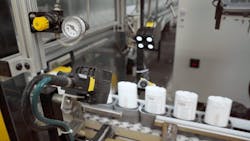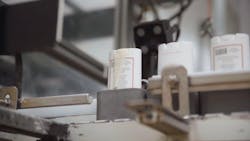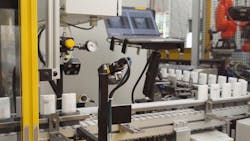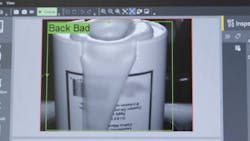Federal Package Uses Smart Camera System to Inspect Deodorant Products
Federal Package, a contract manufacturer of personal care products, deployed an edge-based AI-enabled camera system to inspect the outside of plastic containers used for solid deodorant.
The company purchased the camera system—the In-Sight 2800 from Cognex (Natick, MA, USA)—in 2022 to detect deodorant drips on the outside of the containers. Over time, however, the AI-enabled algorithms learned to detect other cosmetic imperfections with the containers.
And, while the project began with plastic deodorant containers, engineers have since purchased additional camera systems for inspection processes on other production lines.
Based in a Minneapolis suburb, 70-employee Federal Package (Chanhassen, MN, USA) specializes in producing solid deodorants, sunscreen, lotions, serums, and lip balm. In fact, it is the largest manufacturer of lip balm in the United States, producing 15 million tubes a year, explains Jeffrey Martin, marketing director at Federal Package.
“We do a lot of household brands and all the way down to the smaller, emerging independent brands,” Martin says.
As a contract manufacturer, Federal Package either works with a client’s existing formula, fragrance, container, and packaging, or helps develop those elements to create a new product.
Related: Bringing 20/20 Vision to the Edge with AI Inferencing
Before the deodorant inspection project, Federal Package used vision systems exclusively for optical character recognition (OCR) such as for inspecting lot numbers. “This was the first time we used it for some other kind of purpose,” Noah Leuer, manufacturing engineering manager, explains.
Goals of the Vision System
The decision to add a machine vision system to replace human inspectors for deodorant containers was part of an overall plan to automate the entire line.
There were two primary goals for the automated inspection process, which Federal Package’s employees implemented without outside integrators or consultants.
First, engineers wanted a fast and easy process to switch from producing one stock keeping unit (SKU) to another one. “We’ve done at least 60 to 80 different types of fragrances on that line of the same product. So, the colors on the front change and the names change, and we didn’t want to have to set up the camera every single time we do a new product because that would be very annoying,” Leuer says.
The second goal was reliability. Federal Package wanted the new system to catch deodorant drips with a high rate of accuracy.
An Edge-Based, AI-Enabled System
The solid deodorant products inspected on the line with the camera system are from Native (San Francisco, CA, USA) an all-natural brand. The products come in many fragrances including limited editions, and each one has a unique screen-printed label. There also are versions of the product for sensitive skin.
The deodorant products from Native have labels that are screen printed onto the plastic containers, which arrive at Federal Package ready-made from another supplier.
Federal Package chose two monochrome In-Sight 2800 2D vision systems for the deodorant line. “The monochrome works nicely for this solution because we are not looking for color,” he adds.
The system is self-contained. It snaps and processes images, produces results, and sends instructions directly to other pieces of automation equipment without requiring a PLC. It uses a combination of AI- and rules-based algorithms to solve error-proofing projects, such as categorization.
“I don't have to have any other logic, it's all done on the camera, which is really convenient for us,” Leuer says.
How the Manufacturing and Inspection Process Works
For the deodorant line, containers, which are positioned upside down and eight across per row, are filled with liquid deodorant. The containers then go through a cooling tunnel, which solidifies the product.
Afterward, a blade pulls the containers onto a single-track conveyor and the inspection process begins. Federal Package set up two Cognex cameras, with each one taking a picture of one side of a deodorant container as it moves through the line.
Related: Gaining an Edge on Line Control
Because Federal Package doesn’t control the orientation of each container as it passes by the cameras, they each take an image of whatever side is facing them.
There are four decision points for the system: front good, front bad, back good, back bad.
The cameras work at a rate of 100 containers per minute.
When products do not pass inspection, the smart camera sends a signal to a relay device, which then alerts an air cylinder to kick the product off the line and into a bin.
Even though the system is self-contained, Leuer says they decided to connect a laptop to the cameras, so employees can periodically check the images displayed on the screen as the products go by. They also can use the laptop to make changes to the system.
Automation equipment in other work cells add a plug to the bottom of each container to seal it and weigh each product. A pre-existing OCR process reads lot codes on the bottom of the containers using a CV-X camera from Keyence (Itasca, IL, USA).
Training the Embedded Vision Algorithms
Cognex markets the product as an edge-learning solution because it is packaged with a set of preexisting algorithms for factory automation tasks such as presence/absence detection, sortation, and character reading. While Cognex completed training of the algorithms as part of the development process, end users do additional training with images specific to their use cases.
In Federal Package’s case, employees used about 50 images per category: front good, front bad, back good, and back bad, Leuer says. “It was kind of intense to set up, but once we did, it works for a lot of different (Native deodorant) products.”
At this point, Leuer says he is called in to address an issue with the system “once every three months.” Otherwise, Federal Package’s maintenance staff operates and monitors the system, which detects errors with nearly 100% accuracy.
Martin says he is surprised by the errors that the system catches. “I’ve looked at the pieces that get kicked out, and there's been a couple times where I've been kind of hard pressed to see what the defect is.”
In addition to the drips, Leuer says the cosmetic imperfections that the system now spots include nicks in the plastic and errors in the screen-printed labels, such as those that are upside down or have smudged letters. “We’ve caught issues that we were not necessarily looking for just because it is looking for anything that is not normal,” Leuer explains.
Adding Machine Vision to Other Manufacturing Processes
Federal Package’s engineers have since deployed the In-Sight 2800 to inspect adhesive labels affixed to the outside of containers. These labels are used for many different products for myriad customers.
They chose the color version of the camera for this application because it recognizes label edges on containers of many different colors more easily than the monochrome version. For example, recognizing a white label on a white container would be more difficult with a monochrome camera, Leuer says.
Related: Machine Vision System Enables Flexible Bottle Inspection
After the automated inspection of the adhesive labels, employees inspect the containers looking for defects the cameras may have missed.
There are numerous labeling machines at Federal Package for adhesive labels, including those that affix security labels to the tops of containers, those that affix front and back labels on a container, and still others that apply a single label on round containers.
“There's a lot that can go wrong: bubbles, wrinkles, SKU issues,” Leuer says.
In this application, the system catches 80% of the defects.
Leuer says Federal Package decided not to invest the time to improve the system’s performance to the level achieved with the Native products because of employees’ involvement in the inspection process. “We could spend more time to get them perfect, but we would gain very little and waste time,” he explains.
So far, Federal Package has added the cameras to four labeling machines and plans to add them to other machines over time.
Overall, Leuer says, the process has persuaded him that machine vision should be an element of every new automation project at the plant. “We’re adding vision to basically every project that we do now because it’s so convenient for quality inspections," he says.
About the Author
Linda Wilson
Editor in Chief
Linda Wilson joined the team at Vision Systems Design in 2022. She has more than 25 years of experience in B2B publishing and has written for numerous publications, including Modern Healthcare, InformationWeek, Computerworld, Health Data Management, and many others. Before joining VSD, she was the senior editor at Medical Laboratory Observer, a sister publication to VSD.




